13 Best Trees To Plant For Fall Color In The South
Set your garden aglow with autumn foliage.
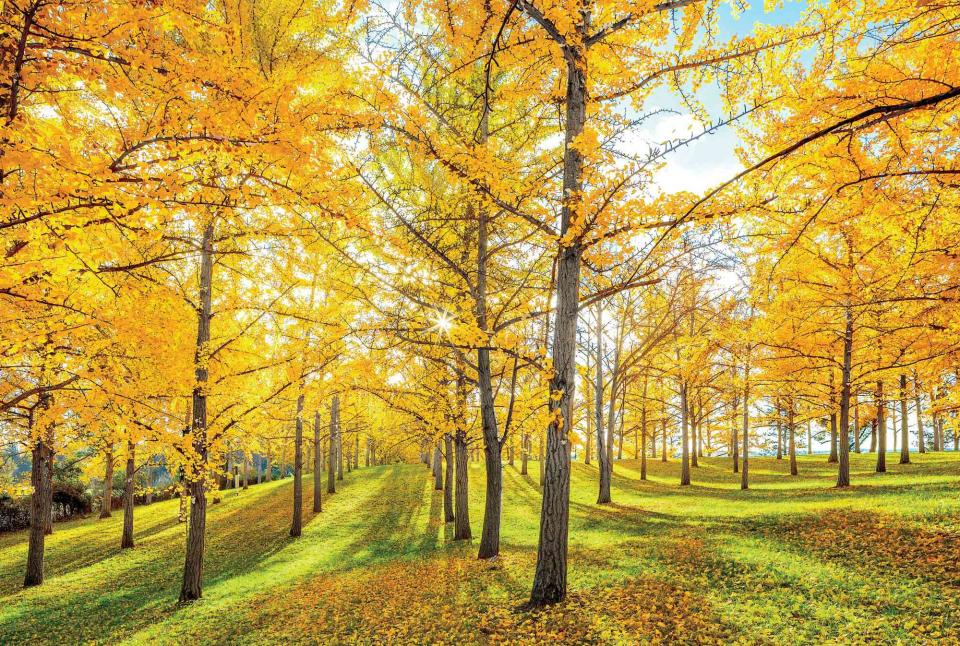
Maybe the South doesn't brag about its blazing fall colors (because that's just bad manners), but Southern gardeners can enjoy autumn splendor every bit as lovely as the sugar maples in Vermont or the aspens in the Rockies.
"Many trees that are suited to the South do feature showstopping fall colors," says Greg Huber, a Georgia Registered Landscape Architect (RLA) and program coordinator of the certified landscape and plant professional programs at the Georgia Center for Urban Agriculture, University of Georgia. "Autumn also is a good time to plant because milder conditions in the fall, winter and spring are conducive to root development so your tree can withstand heat better next summer."
When shopping, remember to read the tree's description or plant tag so that you know it can survive winters in your USDA plant hardiness zone. Also, make sure you choose the perfect spot in your yard. Tree colors are brilliantly lit around sunrise and sunset, so careful tree placement can maximize visual impact as the foliage changes, says Huber. Finally, don't forget to pay attention to a tree's mature height and spread, or width. "It would be a tragedy to spend years nurturing a tree only to have to cut it down or slay it with heavy pruning because it outgrew your space," says Huber.
To get you started, we'll give you some inspiration on the most beautiful trees for fall color in Southern climes.
Meet The Expert
Greg Huber is a Georgia Registered Landscape Architect (RLA) and program coordinator of the certified landscape and plant professional programs at the Georgia Center for Urban Agriculture, University of Georgia.
Red Maple
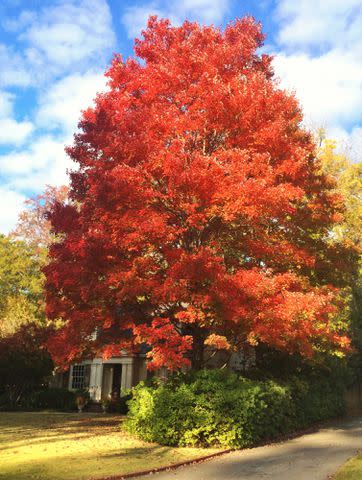
Botanical Name: Acer rubrum
Sun Exposure: Full, partial
Soil Type: Average, well-drained but moist
Soil pH: Slightly acidic to neutral
This native maple makes an excellent accent tree with its silvery furrowed bark and oval form. It's also one of the first trees to change color in the fall, with leaves that glow a brilliant red in the sunlight. Red maples eventually grow to about 70 feet high and 30 to 50 feet wide. 'Somerset' is a variety that performs well in heat and humidity, though you can't plant it south of zone 9.
Gingko
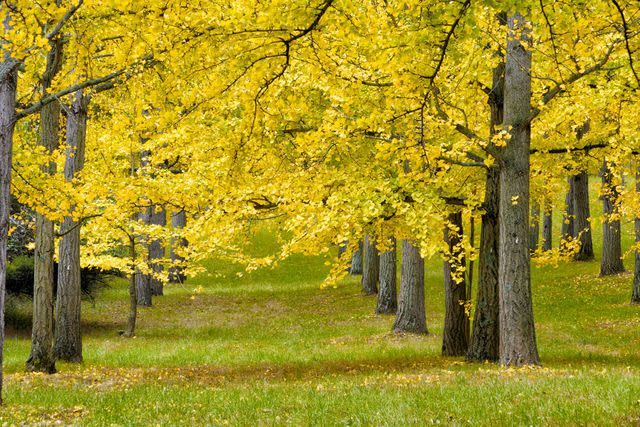
Botanical Name: Ginkgo biloba
Sun Exposure: Full
Soil Type: Well-drained
Soil pH: Acidic to alkaline
This long-lived and tough tree has beautiful fan-shaped leaves and grows to 50-80 feet tall and 30-40 feet wide. The leaves of the ginkgo or maidenhair tree turn bright yellow or golden in fall. Unfortunately, the fruit of the female tree is messy and smells disgusting as it decomposes. However, if you have your heart set on this tree, seek out a male cultivar, which will not bear fruit. Look for 'Autumn Gold' or 'Goldspire,' which has a striking columnar form. They can be planted in zones 9 and cooler.
Japanese Maple
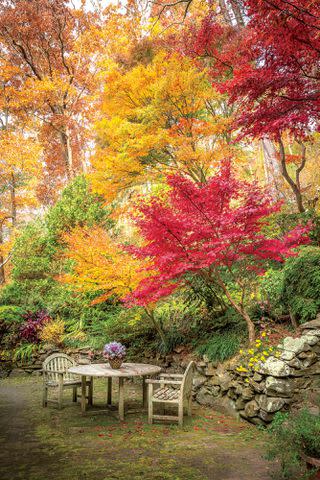
Botanical Name: Acer palmatum
Sun Exposure: Partial, dappled
Soil Type: Organically rich, well-drained but moist
Soil pH: Mildly acidic (5.5-6.5)
Japanese maples are graceful, elegant trees that fit in even the smallest gardens. They come in a wide variety of different sizes and weeping or upright forms; read the plant tags carefully so you know what you're buying. Every type has interesting foliage and unmatched fall color. A few stand-out cultivars include 'Seiryu,' 'Fireglow,' 'Katsura,' or 'Osakazuki.' Japanese maples grow best in zones 5-8.
Chinese Pistache
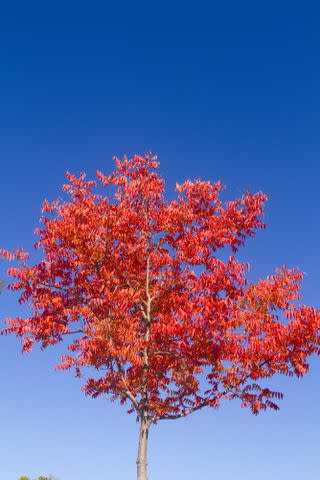
Botanical Name: Pistacia chinensis
Sun Exposure: Full
Soil Type: Well-drained but moist
Soil pH: Acidic to alkaline (5.5-7.5)
Native to China and the Philippines, this tree has long, slender leaves that turn fiery orange and red in fall. Chinese pistache has a rounded crown and can grow to 35 feet high and 20 or 30 feet wide, a compact size suited to planting along a patio or driveway. It's also heat and drought tolerant and can handle most types of soil, including sandy and rocky. Plant this tree in zones 6-9.
Bald Cypress
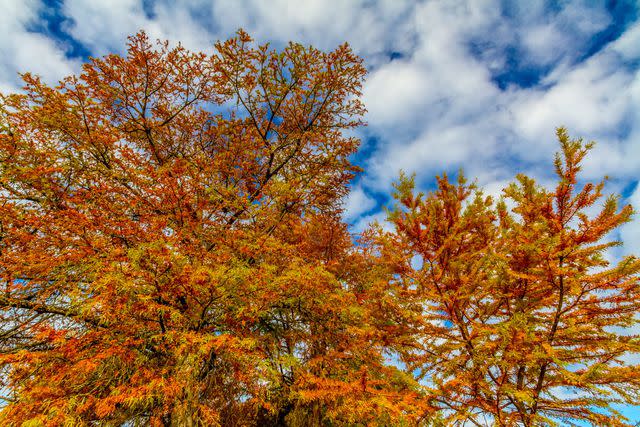
Botanical Name: Taxodium distichum
Sun Exposure: Full, partial
Soil Type: Moist, sandy
Soil pH: Acidic (5.5-6.8)
This native tree is a deciduous conifer with feathery foliage that turns a beautiful rusty orange in fall. Bald cypress is an excellent choice for moist or wet acidic soils in zone 4-9 gardens. It's known for surviving in the saturated flood plains of the Southeast, but can also handle some dryness. You're going to need a lot of space for this pyramid-shaped tree, but it provides impressive amounts of shade once mature.
Black Gum
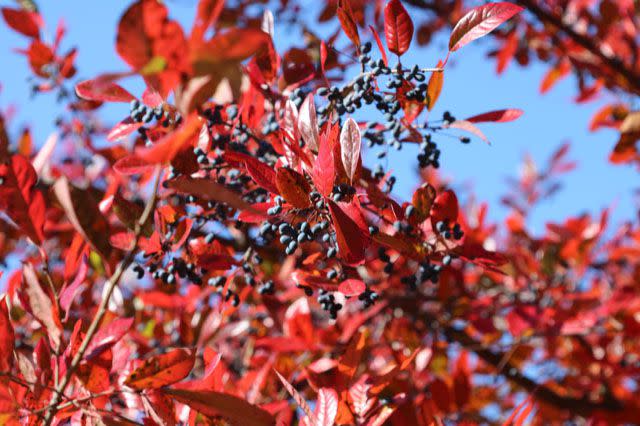
Botanical Name: Nyssa sylvatica
Sun Exposure: Full
Soil Type: Well-drained but moist
Soil pH: Acidic (5.5-6.5)
This less commonly known native tree, also called tupelo, grows slowly to 30 or 40 feet tall and is a great medium-sized choice for more compact gardens. Black gum holds onto its leaves longer than many other deciduous trees before putting on its show. The tree can handle partial shade, but will turn a more brilliant scarlet in full sun. 'Zydeco Twist' is a variety with eye-catching zig zag branches that add winter interest to your garden. Black gum will adapt to most soil conditions, but must be planted in acidic soil. Grow in zones 4-9.
Crepe Myrtle
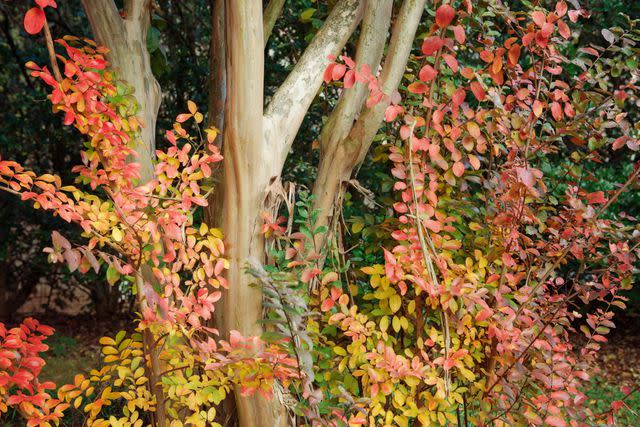
Botanical Name: Lagerstroemia indica
Sun Exposure: Full
Soil Type: Well-drained but moist
Soil pH: Slightly acidic (6.0-6.5)
Most Southerners grow crepe myrtles for the non-stop summer blooms, but this small specimen tree can also be beautiful in fall. The tree should be allowed to grow in its natural form instead of pruning it back. Selective pruning to remove dead, broken or cross-branched limbs is fine, but otherwise, leave it alone. Cultivars that are mildew resistant and have great fall color include 'Acoma,' 'Biloxi,' and 'Natchez.' Fall color can range from yellow to orange to red, depending on the variety. Though it likes slightly acidic and well-drained soil, this tough, heat-tolerant tree can adapt to many soils and will even grow in clay. Plant in zones 6-9.
Southern Sugar Maple
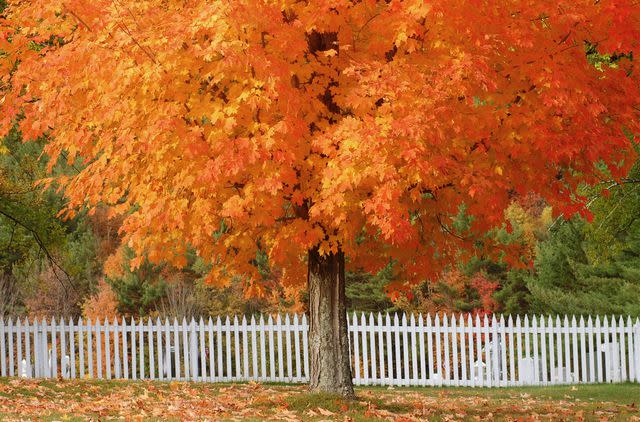
Botanical Name: Acer saccharum subsp. floridanum
Sun Exposure: Full, partial
Soil Type: Well-drained, moist
Soil pH: Acidic to slightly alkaline (5.5-7.3)
Yes, you can have the classic fall color of a sugar maple in the South. This heat-tolerant subspecies is sometimes also called Florida maple and can be grown as far south as zone 9b. Like many types of maples, it's a fast grower and needs plenty of space. Fall foliage can range from yellow to orangey red. Sugar maples often grow in rich, moist bottomlands in the wild. 'Caddo' is a selection from Oklahoma that grows well in dry and alkaline soils,
Paperbark Maple
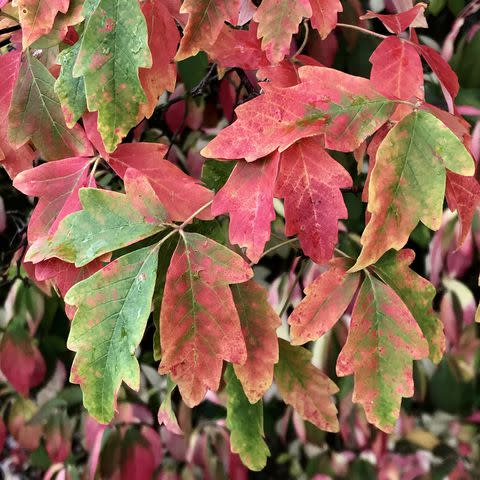
Botanical Name: Acer griseum
Sun Exposure: Full, partial
Soil Type: Well-drained but moist
Soil pH: Acidic to slightly alkaline (5.5-7.5)
This medium-sized tree, native to central China, has cinnamon-colored peeling bark that provides year-round interest, especially in the otherwise bleak winter landscape. The red or orange fall foliage also often persists into winter. It's a fairly slow grower and only reaches 20 or 30 feet, making this a good accent tree for your patio. Paperbark maple requires a moist location and will not grow south of zone 8.
Serviceberry
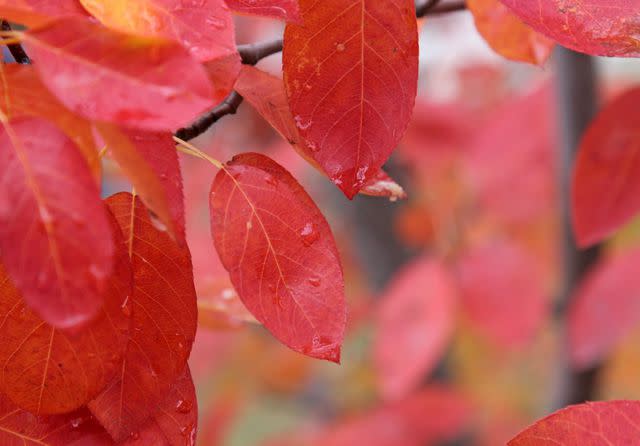
Botanical Name: Amelanchier spp.
Sun Exposure: Full, partial
Soil Type: Well-drained but moist, loamy
Soil pH: Acidic to neutral (5.5-7.0)
This small to medium-sized tree is just about perfect, with abundant white blossoms in spring, edible summer fruit for jellies and jams (if you get to it before the birds do), and gorgeous autumn color. Also known as Juneberry, this plant can be grown as a tree or multi-stemmed shrub. Serviceberry's leaves can turn gold, red, or burgundy. Look for the hybrid cultivar 'Autumn Brilliance' for unmatched fall foliage. It can be grown in zones 4-9.
'Forest Pansy' Redbud
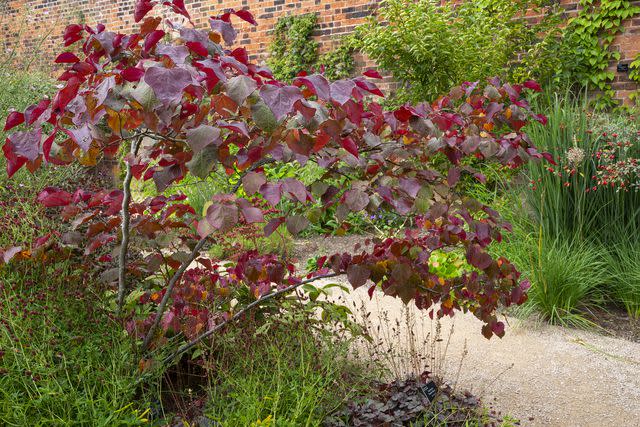
R A Kearton / Getty Images
Botanical Name: Cercis canadensis 'Forest Pansy'
Sun Exposure: Full, partial
Soil Type: Well-drained but moist, organically rich
Soil pH: Acidic to neutral (5.5-7.0)
Redbud trees light up forest edges in spring, covered in tiny purplish-pink blossoms. But the heart-shaped foliage gets a second season of interest in the fall. While the redbud's typical yellow fall color can be perfectly lovely, there is one selection with exciting color that transforms throughout the year. 'Forest Pansy' starts as burgundy in the spring, turns to deep green in summer, and then changes again to red-orange in the fall. Grows in zones 4-9.
Flowering Dogwood
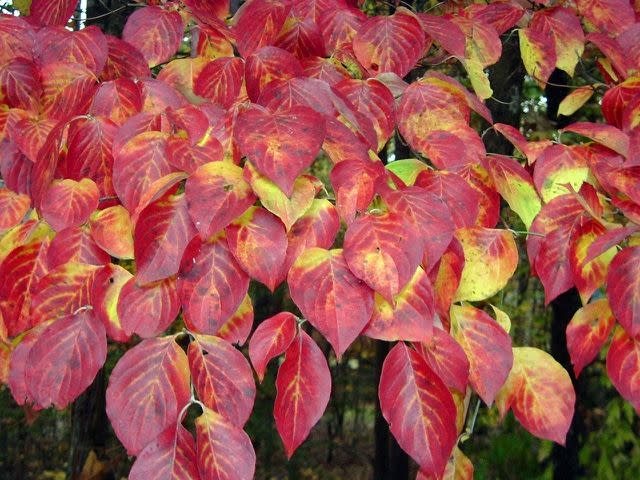
Botanical Name: Cornus florida
Sun Exposure: Full, partial
Soil Type: Well-drained but moist, organically rich
Soil pH: Slightly acidic to neutral (5.5-7.0)
Another understory tree of the forest margins, this native dogwood is blessed with white spring flowers, bright red berries, and attractive fall color. The leaves often have spotty color in fall, resulting in an interesting array of green, yellow, red, and burgundy—sometimes all on one leaf. Plant this small tree in organically rich, well-drained soil, and give it some protection from afternoon sun in a hot site. Flowering dogwood can be grown in zones 5-9.
Scarlet Oak
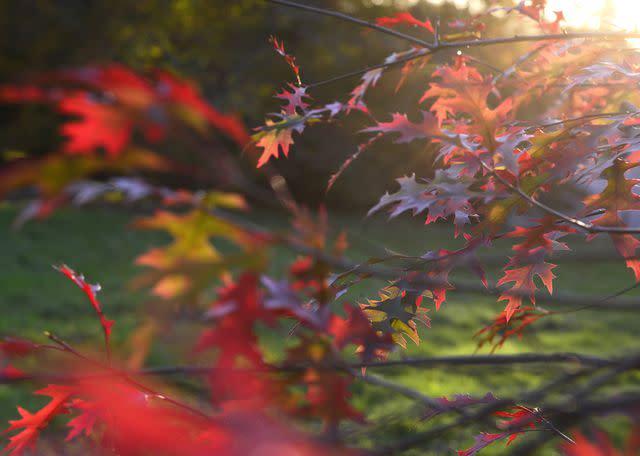
Kathy Collins/ Getty Images
Botanical Name: Quercus coccinea
Sun Exposure: Full
Soil Type: Well-drained, sandy
Soil pH: Acidic (6.0 and below)
Scarlet oak is a popular shade tree because of its brilliant fall color. This large, fast-growing oak will grow at least 50 feet tall and needs plenty of room to spread out so it can shade you in summer and provide an ample home for wildlife. Plant it in zones 4-9 in sandy or well-drained, acidic soil, then wait for it to put on its show in fall. The large acorns are also fun to collect and display with your fall decor.
For more Southern Living news, make sure to sign up for our newsletter!
Read the original article on Southern Living.

